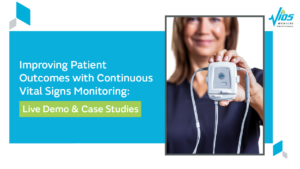
Why are Post Operative Vital Signs Important?
Following surgery, patients are at an elevated risk of complications associated with anesthesia, the surgical site, and recovery from the pain associated with the procedure. Vital signs are commonly used to provide insight into the patient’s well-being and provide early indications of any side effects or a deteriorating condition. Identifying these conditions in their early stages of development can streamline treatment and result in improved patient outcomes.
What are Important Post Op Vital Signs?
Vital signs commonly monitored postoperatively include heart rate, blood pressure, respiratory rate, body temperature, and oxygen saturation. Postoperative patients are at a higher risk for bleeding, infection, and respiratory distress. Additionally, pain is common after most types of surgical procedures and, if left unresolved, may have many negative effects. Pain medications, such as opioids, can cause respiratory depression and lead to a drop in respiratory rate or oxygen saturation.1 Monitoring vital signs ensures timely intervention and management of potential postoperative complications.
Common Post Operative Vital Signs to Monitor
Early detection of abnormal vital signs can help healthcare providers intervene promptly, reducing the risk of severe health issues, cutting costs for patients and providers, and saving time that would otherwise be spent fixing potentially avoidable catastrophes.
Heart Rate
An increase in heart rate postoperatively can indicate the onset of infection. Regular monitoring is crucial as changes in heart rate can signal potential complications.
Blood Pressure
A drop in blood pressure may indicate the onset of internal bleeding or hypovolemia. It is essential to monitor blood pressure closely to detect and address any critical changes promptly.
Body Temperature
An increase in body temperature postoperatively could signal the onset of infection. Monitoring body temperature helps in identifying and managing potential infections early.
What Is the Frequency of Post Op Vitals Checks?
Post op vitals frequency depends on the patient and their condition. Patients admitted to a post-operative recovery unit following anesthesia usually have their vitals taken according to established policy, such as every 15 minutes for 1 hour, every 30 minutes for 2 hours, and then every 4 hours for 24 hours, although this may be modified.
What Are the Types of Post Op Vitals Monitoring?
Postoperative complications, such as bleeding, cardiovascular events, and infection, remain high despite current monitoring standards. The early warning signs that vital signs measurement may produce are often missed due to long intervals between routine vital signs spot checks by nurses. It may be reasonable to assume that increasing the frequency of vital signs monitoring would lead to earlier detection of an abnormal condition and prevent patient deterioration.
Manual spot checks are routine in current clinical practice. While they may overlook changes between scheduled intervals, they facilitate a physical assessment of the patient’s condition at the bedside. Automated measurement of vital signs can enable more rapid identification of a declining condition but can also overwhelm clinical staff with false alarms. Mobile measurement solutions allow monitoring while patients move about during their recovery but may lack the sensitivity and specificity needed by healthcare professionals for an accurate assessment of a condition.
How Patient Remote Monitoring Could Revolutionize Post Operative Vital Signs Monitoring
A pragmatic approach may be to apply continuous vital signs monitoring to all patients postoperatively. However, most patients do not experience any critical signs or abnormalities. A site-specific protocol may be developed that recommends patient types and conditions that justify the additional monitoring. Cardiovascular conditions, respiratory distress, and those at risk for infection may be a starting point for a healthcare facility’s continuous monitoring program.
Patient compliance is critical to overcoming the challenges of monitoring methods and devices. The ideal device configuration needs to be small, wireless, and wearable so the patient is unencumbered during normal activities and is not burdened by its presence.
Excessive alarm is often a condition inherent in continuous vital signs monitoring. The fundamental value of monitoring is the ability to accurately detect and appropriately alert. To achieve this, alarms must be customized to an individual’s needs. The sensitivity and specificity of the device must be capable of detecting actionable clinical events without burdening clinicians with false alarms and the possibility of alarm fatigue. Finally, the condition must be identified in real-time so the appropriate treatment can be determined and administered appropriately.
In summary, continuous vital signs monitoring in a post-operative care setting has the potential for significant clinical improvements. The benefit of constant monitoring can be realized when deployed with patients whose condition is more prone to vital signs abnormalities. The integrity of the monitoring solution deployed is critical in assuring that clinically relevant events are noted promptly and the appropriate response is guaranteed.
Improve Patient Outcomes with Remote Post Operative Vital Signs Monitoring
Remote vital sign monitoring solutions from providers like Vios Medical can significantly improve postoperative practices and patient outcomes. These advanced systems allow for continuous, real-time monitoring of patients’ vital signs, enabling healthcare providers to detect and respond to complications swiftly. This not only enhances patient safety but also reduces the costs and time associated with managing avoidable complications.



